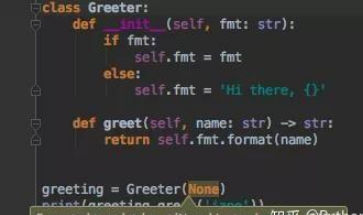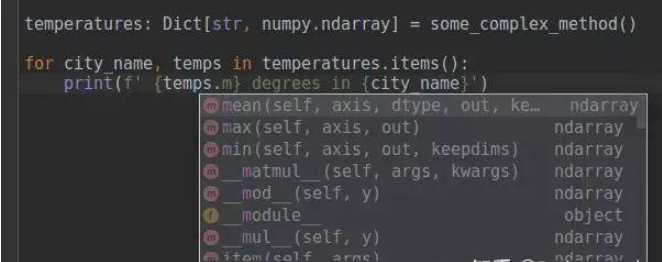您好,登錄后才能下訂單哦!
您好,登錄后才能下訂單哦!
這篇文章主要講解了“怎么使用Python3中的pathlib”,文中的講解內容簡單清晰,易于學習與理解,下面請大家跟著小編的思路慢慢深入,一起來研究和學習“怎么使用Python3中的pathlib”吧!
使用pathlib處理更好的路徑
pathlib 是 Python3 中的一個默認模塊,可以幫助你避免使用大量的 os.path.join。
from pathlib import Path
dataset = 'wiki_images'
datasets_root = Path('/path/to/datasets/')
#Navigating inside a directory tree,use:/
train_path = datasets_root / dataset / 'train'
test_path = datasets_root / dataset / 'test'
for image_path in train_path.iterdir():
with image_path.open() as f: # note, open is a method of Path object
# do something with an image不要用字符串鏈接的形式拼接路徑,根據操作系統的不同會出現錯誤,我們可以使用/結合 pathlib來拼接路徑,非常的安全、方便和高可讀性。
pathlib 還有很多屬性,具體的可以參考pathlib的官方文檔,下面列舉幾個:
from pathlib import Path
a = Path("/data")
b = "test"
c = a / b
print(c)
print(c.exists()) # 路徑是否存在
print(c.is_dir()) # 判斷是否為文件夾
print(c.parts) # 分離路徑
print(c.with_name('sibling.png')) # 只修改拓展名, 不會修改源文件
print(c.with_suffix('.jpg')) # 只修改拓展名, 不會修改源文件
c.chmod(777) # 修改目錄權限
c.rmdir() # 刪除目錄類型提示現在是語言的一部分
一個在 Pycharm 使用Typing的例子:

引入類型提示是為了幫助解決程序日益復雜的問題,IDE可以識別參數的類型進而給用戶提示。
關于Tying的具體用法,可以參考:python類型檢測最終指南--Typing的使用
運行時類型提示類型檢查
除了之前文章提到 mypy 模塊繼續類型檢查以外,還可以使用 enforce 模塊進行檢查,通過 pip 安裝即可,使用示例如下:
import enforce
@enforce.runtime_validation
def foo(text: str) -> None:
print(text)
foo('Hi') # ok
foo(5) # fails輸出
Hi Traceback (most recent call last): File "/Users/chennan/pythonproject/dataanalysis/e.py", line 10, in <module> foo(5) # fails File "/Users/chennan/Desktop/2019/env/lib/python3.6/site-packages/enforce/decorators.py", line 104, in universal _args, _kwargs, _ = enforcer.validate_inputs(parameters) File "/Users/chennan/Desktop/2019/env/lib/python3.6/site-packages/enforce/enforcers.py", line 86, in validate_inputs raise RuntimeTypeError(exception_text) enforce.exceptions.RuntimeTypeError: The following runtime type errors were encountered: Argument 'text' was not of type <class 'str'>. Actual type was int.
使用@表示矩陣的乘法
下面我們實現一個最簡單的ML模型——l2正則化線性回歸(又稱嶺回歸)
# l2-regularized linear regression: || AX - y ||^2 + alpha * ||x||^2 -> min # Python 2 X = np.linalg.inv(np.dot(A.T, A) + alpha * np.eye(A.shape[1])).dot(A.T.dot(y)) # Python 3 X = np.linalg.inv(A.T @ A + alpha * np.eye(A.shape[1])) @ (A.T @ y)
使用@符號,整個代碼變得更可讀和方便移植到其他科學計算相關的庫,如numpy, cupy, pytorch, tensorflow等。
**通配符的使用
在 Python2 中,遞歸查找文件不是件容易的事情,即使是使用glob庫,但是從 Python3.5 開始,可以通過**通配符簡單的實現。
import glob
# Python 2
found_images = (
glob.glob('/path/*.jpg')
+ glob.glob('/path/*/*.jpg')
+ glob.glob('/path/*/*/*.jpg')
+ glob.glob('/path/*/*/*/*.jpg')
+ glob.glob('/path/*/*/*/*/*.jpg'))
# Python 3
found_images = glob.glob('/path/**/*.jpg', recursive=True)更好的路徑寫法是上面提到的 pathlib ,我們可以把代碼進一步改寫成如下形式。
# Python 3
import pathlib
import glob
found_images = pathlib.Path('/path/').glob('**/*.jpg')Print函數
雖然 Python3 的 print 加了一對括號,但是這并不影響它的優點。
使用文件描述符的形式將文件寫入
print >>sys.stderr, "critical error" # Python 2
print("critical error", file=sys.stderr) # Python 3不使用 str.join 拼接字符串
# Python 3 print(*array, sep=' ') print(batch, epoch, loss, accuracy, time, sep=' ')
重新定義 print 方法的行為
既然 Python3 中的 print 是一個函數,我們就可以對其進行改寫。
# Python 3 _print = print # store the original print function def print(*args, **kargs): pass # do something useful, e.g. store output to some file
注意:在 Jupyter 中,最好將每個輸出記錄到一個單獨的文件中(跟蹤斷開連接后發生的情況),這樣就可以覆蓋 print 了。
@contextlib.contextmanager
def replace_print():
import builtins
_print = print # saving old print function
# or use some other function here
builtins.print = lambda *args, **kwargs: _print('new printing', *args, **kwargs)
yield
builtins.print = _print
with replace_print():
<code here will invoke other print function>雖然上面這段代碼也能達到重寫 print 函數的目的,但是不推薦使用。
print 可以參與列表理解和其他語言構造
# Python 3
result = process(x) if is_valid(x) else print('invalid item: ', x)數字文字中的下劃線(千位分隔符)
在 PEP-515 中引入了在數字中加入下劃線。在 Python3 中,下劃線可用于整數,浮點和復數,這個下劃線起到一個分組的作用
# grouping decimal numbers by thousands
one_million = 1_000_000
# grouping hexadecimal addresses by words
addr = 0xCAFE_F00D
# grouping bits into nibbles in a binary literal
flags = 0b_0011_1111_0100_1110
# same, for string conversions
flags = int('0b_1111_0000', 2)也就是說10000,你可以寫成10_000這種形式。
簡單可看的字符串格式化f-string
Python2提供的字符串格式化系統還是不夠好,太冗長麻煩,通常我們會寫這樣一段代碼來輸出日志信息:
# Python 2
print '{batch:3} {epoch:3} / {total_epochs:3} accuracy: {acc_mean:0.4f}±{acc_std:0.4f} time: {avg_time:3.2f}'.format(
batch=batch, epoch=epoch, total_epochs=total_epochs,
acc_mean=numpy.mean(accuracies), acc_std=numpy.std(accuracies),
avg_time=time / len(data_batch)
)
# Python 2 (too error-prone during fast modifications, please avoid):
print '{:3} {:3} / {:3} accuracy: {:0.4f}±{:0.4f} time: {:3.2f}'.format(
batch, epoch, total_epochs, numpy.mean(accuracies), numpy.std(accuracies),
time / len(data_batch)
)輸出結果為
120 12 / 300 accuracy: 0.8180±0.4649 time: 56.60
在 Python3.6 中引入了 f-string (格式化字符串)
print(f'{batch:3} {epoch:3} / {total_epochs:3}
accuracy: {numpy.mean(accuracies):0.4f}±{numpy.std(accuracies):0.4f} time: {time / len(data_batch):3.2f}')關于 f-string 的用法可以看我在b站的視頻[https://www.bilibili.com/video/av31608754]
'/'和'//'在數學運算中有著明顯的區別
對于數據科學來說,這無疑是一個方便的改變
data = pandas.read_csv('timing.csv')
velocity = data['distance'] / data['time']Python2 中的結果取決于“時間”和“距離”(例如,以米和秒為單位)是否存儲為整數。在python3中,這兩種情況下的結果都是正確的,因為除法的結果是浮點數。
另一個例子是 floor 除法,它現在是一個顯式操作
n_gifts = money // gift_price # correct for int and float arguments
nutshell
>>> from operator import truediv, floordiv
>>> truediv.__doc__, floordiv.__doc__
('truediv(a, b) -- Same as a / b.', 'floordiv(a, b) -- Same as a // b.')
>>> (3 / 2), (3 // 2), (3.0 // 2.0)
(1.5, 1, 1.0)值得注意的是,這種規則既適用于內置類型,也適用于數據包提供的自定義類型(例如 numpy 或pandas)。
嚴格的順序
下面的這些比較方式在 Python3 中都屬于合法的。
3 < '3' 2 < None (3, 4) < (3, None) (4, 5) < [4, 5]
對于下面這種不管是2還是3都是不合法的
(4, 5) == [4, 5]
如果對不同的類型進行排序
sorted([2, '1', 3])
雖然上面的寫法在 Python2 中會得到結果 [2, 3, '1'],但是在 Python3 中上面的寫法是不被允許的。
檢查對象為 None 的合理方案
if a is not None: pass if a: # WRONG check for None pass
NLP Unicode問題
s = '您好' print(len(s)) print(s[:2])
輸出內容
Python 2: 6 ?? Python 3: 2 您好.
還有下面的運算
x = u'со' x += 'co' # ok x += 'со' # fail
Python2 失敗了,Python3 正常工作(因為我在字符串中使用了俄文字母)。
在 Python3 中,字符串都是 unicode 編碼,所以對于非英語文本處理起來更方便。
一些其他操作
'a' < type < u'a' # Python 2: True 'a' < u'a' # Python 2: False
再比如
from collections import Counter
Counter('M?belstück')在 Python2 中
Counter({'?': 2, 'b': 1, 'e': 1, 'c': 1, 'k': 1, 'M': 1, 'l': 1, 's': 1, 't': 1, '?': 1, '?': 1})在 Python3 中
Counter({'M': 1, '?': 1, 'b': 1, 'e': 1, 'l': 1, 's': 1, 't': 1, 'ü': 1, 'c': 1, 'k': 1})雖然可以在 Python2 中正確地處理這些結果,但是在 Python3 中看起來結果更加友好。
保留了字典和**kwargs的順序
在CPython3.6+ 中,默認情況下,dict 的行為類似于 OrderedDict ,都會自動排序(這在Python3.7+ 中得到保證)。同時在字典生成式(以及其他操作,例如在 json 序列化/反序列化期間)都保留了順序。
import json
x = {str(i):i for i in range(5)}
json.loads(json.dumps(x))
# Python 2
{u'1': 1, u'0': 0, u'3': 3, u'2': 2, u'4': 4}
# Python 3
{'0': 0, '1': 1, '2': 2, '3': 3, '4': 4}這同樣適用于**kwargs(在Python 3.6+中),它們的順序與參數中出現的順序相同。當涉及到數據管道時,順序是至關重要的,以前我們必須以一種繁瑣的方式編寫它
from torch import nn
# Python 2
model = nn.Sequential(OrderedDict([
('conv1', nn.Conv2d(1,20,5)),
('relu1', nn.ReLU()),
('conv2', nn.Conv2d(20,64,5)),
('relu2', nn.ReLU())
]))而在 Python3.6 以后你可以這么操作
# Python 3.6+, how it *can* be done, not supported right now in pytorch model = nn.Sequential( conv1=nn.Conv2d(1,20,5), relu1=nn.ReLU(), conv2=nn.Conv2d(20,64,5), relu2=nn.ReLU()) )
可迭代對象拆包
類似于元組和列表的拆包,具體看下面的代碼例子。
# handy when amount of additional stored info may vary between experiments, but the same code can be used in all cases model_paramteres, optimizer_parameters, *other_params = load(checkpoint_name) # picking two last values from a sequence *prev, next_to_last, last = values_history # This also works with any iterables, so if you have a function that yields e.g. qualities, # below is a simple way to take only last two values from a list *prev, next_to_last, last = iter_train(args)
提供了更高性能的pickle
Python2
import cPickle as pickle import numpy print len(pickle.dumps(numpy.random.normal(size=[1000, 1000]))) # result: 23691675
Python3
import pickle import numpy len(pickle.dumps(numpy.random.normal(size=[1000, 1000]))) # result: 8000162
空間少了三倍。而且要快得多。實際上,使用 protocol=2 參數可以實現類似的壓縮(但不是速度),但是開發人員通常忽略這個選項(或者根本不知道)。
注意:pickle 不安全(并且不能完全轉移),所以不要 unpickle 從不受信任或未經身份驗證的來源收到的數據。
更安全的列表推導
labels = <initial_value> predictions = [model.predict(data) for data, labels in dataset] # labels are overwritten in Python 2 # labels are not affected by comprehension in Python 3
更簡易的super()
在python2中 super 相關的代碼是經常容易寫錯的。
# Python 2 class MySubClass(MySuperClass): def __init__(self, name, **options): super(MySubClass, self).__init__(name='subclass', **options) # Python 3 class MySubClass(MySuperClass): def __init__(self, name, **options): super().__init__(name='subclass', **options)
這一點Python3得到了很大的優化,新的 super() 可以不再傳遞參數。
同時在調用順序上也不一樣。
IDE能夠給出更好的提示
使用Java、c#等語言進行編程最有趣的地方是IDE可以提供很好的建議,因為在執行程序之前,每個標識符的類型都是已知的。
在python中這很難實現,但是注釋會幫助你

這是一個帶有變量注釋的 PyCharm 提示示例。即使在使用的函數沒有注釋的情況下(例如,由于向后兼容性),也可以使用這種方法。
Multiple unpacking
如何合并兩個字典
x = dict(a=1, b=2)
y = dict(b=3, d=4)
# Python 3.5+
z = {**x, **y}
# z = {'a': 1, 'b': 3, 'd': 4}, note that value for `b` is taken from the latter dict.我在b站同樣發布了相關的視頻[https://www.bilibili.com/video/av50376841]
同樣的方法也適用于列表、元組和集合(a、b、c是任何迭代器)
[*a, *b, *c] # list, concatenating
(*a, *b, *c) # tuple, concatenating
{*a, *b, *c} # set, union函數還支持*arg和**kwarg的多重解包
# Python 3.5+
do_something(**{**default_settings, **custom_settings})
# Also possible, this code also checks there is no intersection between keys of dictionaries
do_something(**first_args, **second_args)Data classes
Python 3.7引入了Dataclass類,它適合存儲數據對象。數據對象是什么?下面列出這種對象類型的幾項特征,雖然不全面:
它們存儲數據并表示某種數據類型,例如:數字。對于熟悉ORM的朋友來說),數據模型實例就是一個數據對象。它代表了一種特定的實體。它所具有的屬性定義或表示了該實體。它們可以與同一類型的其他對象進行比較。例如:大于、小于或等于。
當然還有更多的特性,下面的這個例子可以很好的替代namedtuple的功能。
@dataclass class Person: name: str age: int @dataclass class Coder(Person): preferred_language: str = 'Python 3'
dataclass裝飾器實現了幾個魔法函數方法的功能(__init__,__repr__,__le__,__eq__)
關于數據類有以下幾個特性:
數據類可以是可變的,也可以是不可變的支持字段的默認值可被其他類繼承數據類可以定義新的方法并覆蓋現有的方法初始化后處理(例如驗證一致性)
更多內容可以參考官方文檔。
自定義對模塊屬性的訪問
在Python中,可以用getattr和dir控制任何對象的屬性訪問和提示。因為python3.7,你也可以對模塊這樣做。
一個自然的例子是實現張量庫的隨機子模塊,這通常是跳過初始化和傳遞隨機狀態對象的快捷方式。numpy的實現如下:
# nprandom.py import numpy __random_state = numpy.random.RandomState() def __getattr__(name): return getattr(__random_state, name) def __dir__(): return dir(__random_state) def seed(seed): __random_state = numpy.random.RandomState(seed=seed)
也可以這樣混合不同對象/子模塊的功能。與pytorch和cupy中的技巧相比。
除此之外,還可以做以下事情:
使用它來延遲加載子模塊。例如,導入tensorflow時會導入所有子模塊(和依賴項)。需要大約150兆內存。
在應用編程接口中使用此選項進行折舊
在子模塊之間引入運行時路由
內置的斷點
在python3.7中可以直接使用breakpoint給代碼打斷點
# Python 3.7+, not all IDEs support this at the moment foo() breakpoint() bar()
在python3.7以前我們可以通過import pdb的pdb.set_trace()實現相同的功能。
對于遠程調試,可嘗試將breakpoint()與web-pdb結合使用.
Math模塊中的常數
# Python 3 math.inf # Infinite float math.nan # not a number max_quality = -math.inf # no more magic initial values! for model in trained_models: max_quality = max(max_quality, compute_quality(model, data))
整數類型只有int
Python 2提供了兩種基本的整數類型,一種是int(64位有符號整數)一種是long,使用起來非常容易混亂,而在python3中只提供了int類型這一種。
isinstance(x, numbers.Integral) # Python 2, the canonical way isinstance(x, (long, int)) # Python 2 isinstance(x, int) # Python 3, easier to remember
在python3中同樣的也可以應用于其他整數類型,如numpy.int32、numpy.int64,但其他類型不適用。
結論
雖然Python 2和Python 3共存了近10年,但是我們應該轉向Python 3。
使用Python3之后,不管是研究還是生產上,代碼都會變得更短,更易讀,更安全。
感謝各位的閱讀,以上就是“怎么使用Python3中的pathlib”的內容了,經過本文的學習后,相信大家對怎么使用Python3中的pathlib這一問題有了更深刻的體會,具體使用情況還需要大家實踐驗證。這里是億速云,小編將為大家推送更多相關知識點的文章,歡迎關注!
免責聲明:本站發布的內容(圖片、視頻和文字)以原創、轉載和分享為主,文章觀點不代表本網站立場,如果涉及侵權請聯系站長郵箱:is@yisu.com進行舉報,并提供相關證據,一經查實,將立刻刪除涉嫌侵權內容。